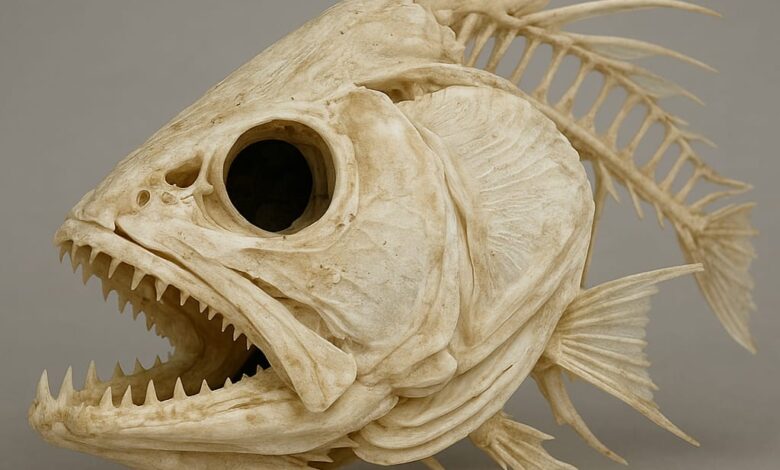
The term “fish skull” may sound like a niche topic, but it opens up a fascinating window into the worlds of biology, evolution, culture, and even home décor. Whether you’re a marine biologist studying fish skulls for research, a collector intrigued by skull fish artwork, or an aquarium enthusiast adding a fish tank skull for aesthetic appeal, there’s more to this topic than meets the eye.
In this article, we dive deep into the structure, significance, and surprising uses of fish skulls, covering everything from anatomy and science to art and aquarium trends.
🧠 What Is a Fish Skull?
A fish skull is the bony framework of a fish’s head that supports and protects critical organs such as the brain, eyes, gills, and jaws. Unlike human skulls, which are rigid and composed of 22 bones, fish skulls are much more complex and flexible, often comprising over 100 bones in some species. This high number of bones allows many fish to have kinetic skulls, meaning their skull bones can move independently—a key trait for feeding and defense.
🔍 Fish Skull Anatomy: Breaking It Down
The anatomy of a fish skull can be divided into three main regions:
1. Neurocranium
- Protects the brain.
- Includes the ethmoid, otic, and occipital regions.
- Typically made of ossified bone in most bony fish.
2. Splanchnocranium
- Supports the jaws, gills, and throat.
- Includes mandibles (lower jaw) and branchial arches (gill support).
3. Dermatocranium
- Composed of dermal bones (formed in the skin).
- Includes plates like the operculum (bony gill cover).
This intricate structure enables various fish species to adapt to unique environments and feeding strategies—whether it’s suction feeding, biting, filtering, or crushing shells.
🦈 Skull Variations in Fish Species
Different types of fish have significantly different skull structures:
| Fish Type | Skull Features |
|---|---|
| Cartilaginous fish (Sharks, Rays) | Skull made of cartilage, not bone; lacks true bone density. |
| Bony fish (Trout, Goldfish) | Ossified skulls with movable jaw parts and operculum. |
| Jawless fish (Lampreys) | Primitive skull; mostly cartilaginous; no true jawbones. |
For example, skull fish like piranhas have robust jaws and thickened cranial bones for delivering powerful bites. In contrast, filter-feeding fish like anchovies have more delicate skulls optimized for maximum water flow through their gills.
🔬 Fish Skulls in Science and Research
The study of fish skulls plays a vital role in:
- Evolutionary biology: Skull changes helped early fish evolve into tetrapods (land vertebrates).
- Comparative anatomy: Understanding similarities between fish and other vertebrates.
- Paleontology: Fossilized fish skulls help scientists reconstruct prehistoric marine life.
For instance, fossil fish like Tiktaalik have transitional skulls showing traits between aquatic and land animals, helping us understand how vertebrates colonized land.
🎣 The Fisher Skull: Symbolism and Culture
The term “fisher skull” isn’t a common anatomical reference, but it’s often used in cultural, artistic, or symbolic contexts. For example:
- Fishermen-themed tattoos or nautical skull art sometimes depict a fisher skull—a stylized skull often merged with fish hooks, boats, or marine themes.
- In mythology and folklore, a skull fish or fisher skull may symbolize the duality of life and death in the sea.
These symbols are often used in literature, fashion, and pop culture to represent the toughness and danger of life at sea.
🏠 Fish Tank Skull: Décor with a Touch of Mystery
In the world of aquarium décor, a fish tank skull has become a popular item. These resin or ceramic decorations resemble skulls—either human, animal, or fantasy-style—and are placed in fish tanks for various reasons:
Why Use a Fish Tank Skull?
- Aesthetics: Creates a mysterious, sunken shipwreck or pirate treasure vibe.
- Shelter: Fish like plecos, cichlids, and betta fish often use skulls as hiding places.
- Territorial Markers: Some fish claim these skulls as their “den.”
- Aeration: Certain skull designs allow bubbles to flow through, enhancing water circulation.
These skulls may mimic realistic fish skulls, or be entirely stylized. Either way, they add personality and a sense of the wild underwater world to any aquarium.
🖼️ Skull Fish in Art and Design
Skull fish is also a term used in art and design, where artists blend skulls and fish shapes to create surreal, gothic, or abstract pieces. These images are commonly found in:
- Tattoos
- Wall art
- Clothing graphics
- 3D printed sculptures
They represent ideas like mortality, nature, transformation, and survival. A skull fish in art might feature a fish’s body with a human-like skull, or a skeletal fish swimming in dark waters.
🔥 Unique Facts About Fish Skulls
Here are some incredible facts to blow your mind:
- 🧬 Jaw Evolution: The jaws in fish evolved from ancient gill arches—a revolutionary adaptation in vertebrate history.
- 🐠 Suction Feeding: Many bony fish use rapid skull expansion to suck in prey—some in less than 5 milliseconds.
- 🦷 Pharyngeal Jaws: Moray eels have a second set of jaws inside their skulls to pull prey deeper.
- 💀 Fossil Skull Fish: Fossils of armored prehistoric fish like Dunkleosteus have skulls with shearing plates instead of teeth.
- 🔩 Kinetic Skull: Some fish can move up to 30 individual bones in their skull when feeding.
⚙️ The Role of Skull Bones in Feeding
The feeding mechanism of fish is one of the most mechanically diverse among vertebrates:
- Suspensorium bones allow expansion of the mouth cavity.
- Premaxilla and maxilla help fish protrude their jaws forward (important in fast-strike predators).
- Opercular bones help open the gill cover and create a water vacuum during suction feeding.
This makes the fish skull a marvel of natural engineering—perfectly tuned for survival.
🧼 How to Clean and Preserve a Real Fish Skull
Some collectors or biology enthusiasts may want to clean a fish skull for display or study. Here’s a basic guide:
Materials:
- Tweezers
- Hydrogen peroxide (not bleach!)
- Dish soap
- Small brushes
Steps:
- Remove all soft tissue after boiling or burying the fish head.
- Soak the skull in peroxide solution to whiten it (never use bleach—it degrades bone).
- Gently scrub and dry.
- For long-term preservation, seal with a thin coat of clear acrylic spray.
Note: Always check local laws and wildlife regulations before collecting or preserving animal remains.
📚 Final Thoughts: Why the Fish Skull Matters
Whether in the wild, in a lab, or in your living room aquarium, the fish skull is a masterpiece of biology, art, and culture. From its intricate bone structures to its role in feeding, respiration, and evolution, the skull tells a story of survival, adaptation, and creativity.
And even beyond science, the concept of a skull fish or fisher skull has swum into our culture as a powerful symbol—often mysterious, sometimes eerie, but always captivating. https://blogvista.co.uk/



